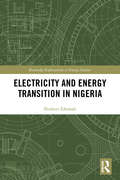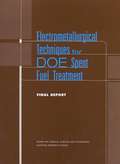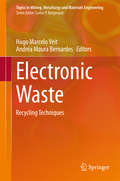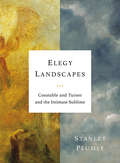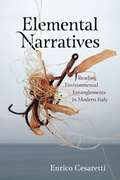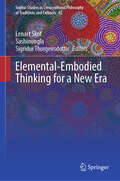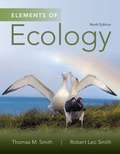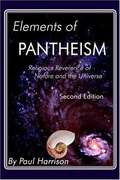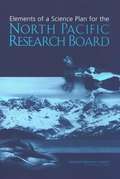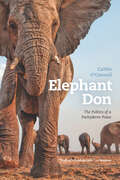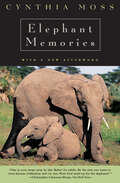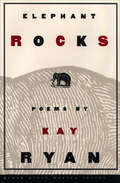- Table View
- List View
Electricity Requirements for a Digital Society
by Scott Hassell Ben A. Vollaard Walter S. BaerGreater use of information and communications technologies (ICTs) marks a U.S. transition toward a "digital society" that may profoundly affect electricity supply, demand, and delivery. RAND developed four 2001-2021 scenarios of ICT evolution and assessed their implications for U.S. electricity requirements. Even large deployment of ICTs will only modestly increase U.S. electricity use over the next two decades. The more pressing concern will be how to meet the increased need for higher-quality and more-reliable power that accompanies ICT use.
Electricity and Energy Transition in Nigeria (Routledge Explorations in Energy Studies)
by Norbert EdomahElectricity and Energy Transition in Nigeria provides readers with a detailed account of the dynamics of energy infrastructure change in Nigeria’s electricity sector. The book starts by introducing the basic theories underpinning the politics of energy infrastructure supply and goes on to explore the historical dimensions of the Nigerian energy transition by highlighting the influences and drivers of energy systems change. Edomah also examines the political dynamics at play, highlighting the political actors and institutions that shape energy supply, as well as the impact of consumer politics. The book concludes by considering how all these factors may influence the future of energy in Nigeria. This book will be of great interest to students and scholars of energy transitions, energy technology and infrastructure, and African Studies more generally.
Electrochemically Assisted Remediation of Contaminated Soils: Fundamentals, Technologies, Combined Processes and Pre-Pilot and Scale-Up Applications (Environmental Pollution #30)
by M. A. Rodrigo E. V. Dos SantosThis book provides an overview of the current development status of remediation technologies involving electrochemical processes, which are used to clean up soils that are contaminated with different types of contaminants (organics, inorganics, metalloids and radioactive). Written by internationally recognized experts, it comprises 21 chapters describing the characteristics and theoretical foundations of various electrochemical applications of soil remediation. The book’s opening section discusses the fundamental properties and characteristics of the soil, which are essential to understand the processes that can most effectively remove organic and inorganic compounds. This part also focuses on the primary processes that contribute to the application of electrochemically assisted remediation, hydrodynamic aspects and kinetics of contaminants in the soil. It also reviews the techniques that have been developed for the treatment of contaminated soils using electrochemistry, and discusses different strategies used to enhance performance, the type of electrode and electrolyte, and the most important operating conditions. In turn, the book’s second part deals with practical applications of technologies related to the separation of pollutants from soil. Special emphasis is given to the characteristics of these technologies regarding transport of the contaminants and soil toxicity after treatment. The third part is dedicated to new technologies, including electrokinetic remediation and hybrid approaches, for the treatment of emerging contaminants by ex-situ and in-situ production of strong oxidant species used for soil remediation. It also discusses pre-pilot scale for soil treatment and the use of solar photovoltaic panels as an energy source for powering electrochemical systems, which can reduce both the investment and maintenance costs of electrochemically assisted processes.
Electrode Materials for Energy Storage and Conversion
by Mesfin A. KebedeThis book provides a comprehensive overview of the latest developments and materials used in electrochemical energy storage and conversion devices, including lithium-ion batteries, sodium-ion batteries, zinc-ion batteries, supercapacitors and conversion materials for solar and fuel cells. Chapters introduce the technologies behind each material, in addition to the fundamental principles of the devices, and their wider impact and contribution to the field. This book will be an ideal reference for researchers and individuals working in industries based on energy storage and conversion technologies across physics, chemistry and engineering. FEATURES Edited by established authorities, with chapter contributions from subject-area specialists Provides a comprehensive review of the field Up to date with the latest developments and research Editors Dr. Mesfin A. Kebede obtained his PhD in Metallurgical Engineering from Inha University, South Korea. He is now a principal research scientist at Energy Centre of Council for Scientific and Industrial Research (CSIR), South Africa. He was previously an assistant professor in the Department of Applied Physics and Materials Science at Hawassa University, Ethiopia. His extensive research experience covers the use of electrode materials for energy storage and energy conversion. Prof. Fabian I. Ezema is a professor at the University of Nigeria, Nsukka. He obtained his PhD in Physics and Astronomy from University of Nigeria, Nsukka. His research focuses on several areas of materials science with an emphasis on energy applications, specifically electrode materials for energy conversion and storage.
Electrometallurgical Techniques for DOE Spent Fuel Treatment: FINAL REPORT
by Committee on Electrometallurgical Techniques for DOE Spent Fuel TreatmentThe National Academies Press (NAP)--publisher for the National Academies--publishes more than 200 books a year offering the most authoritative views, definitive information, and groundbreaking recommendations on a wide range of topics in science, engineering, and health. Our books are unique in that they are authored by the nation's leading experts in every scientific field.
Electronic Waste
by Hugo Marcelo Veit Andréa Moura BernardesThis book presents an overview of the characterization of electronic waste. In addition, processing techniques for the recovery of metals, polymers and ceramics are described. This book serves as a source of information and as an educational technical reference for practicing scientists and engineers, as well as for students.
Elegy Landscapes: Constable And Turner And The Intimate Sublime
by Stanley PlumlyA sweeping look at the lives and work of two important English Romantic painters, from a Los Angeles Times Book Prize–winning author. Renowned poet Stanley Plumly, who has been praised for his “obsessive, intricate, intimate and brilliant” (Washington Post) nonfiction, explores immortality in art through the work of two impressive landscape artists: John Constable and J.M.W. Turner. How is it that this disparate pair will come to be regarded as Britain’s supreme landscape painters, precursors to Impressionism and Modernism? How did each painter’s life influence his work? Almost exact contemporaries, both legendary artists experience a life-changing tragedy—for Constable it is the long illness and death of his wife; for Turner, the death of his singular parent and supporter, his father. Their work will take on new power thereafter: Constable, his Hampstead cloud studies; Turner, his Venetian watercolors and oils. Seeking the transcendent aesthetic awe of the sublime and reeling from their personal anguish, these talented painters portrayed the terrible beauty of the natural world from an intimate, close-up perspective. Plumly studies the paintings against the pull of the artists’ lives, probing how each finds the sublime in different, though inherently connected, worlds. At once a meditation on the difficulties in achieving truly immortal works of art and an exploration of the relationship between artist and artwork, Elegy Landscapes takes a wide-angle look at the philosophy of the sublime.
Elemental Analysis of Airborne Particles
by Sheldon Landsberger Marsha CreatchmanAn increased standard of living in developed and developing countries has brought about a distinct rise in pollution. The problem of air pollution has specifically increased the public's awareness of the environmental and health-related consequences resulting from modern day industrial technology. This detailed collection of works devoted to the most popular methods in elemental analysis of airborne particles offers investigators a comprehensive book on the most common laboratory analytical methods currently used in trace element analysis. Discussed are atomic absorption spectrometry, inductively coupled plasma, atomic emission, particle induced gamma ray analysis, particle elastic scattering and Rutherford backscattering, and neutron activation analysis. Specific sections on quality assurance/quality control and source receptor modeling have also been included.
Elemental Ecocriticism: Thinking with Earth, Air, Water, and Fire
by Jeffrey Jerome Cohen Lowell DuckertFor centuries it was believed that all matter was composed of four elements: earth, air, water, and fire in promiscuous combination, bound by love and pulled apart by strife. Elemental theory offered a mode of understanding materiality that did not center the cosmos around the human. Outgrown as a science, the elements are now what we build our houses against. Their renunciation has fostered only estrangement from the material world. The essays collected in Elemental Ecocriticism show how elemental materiality precipitates new engagements with the ecological. Here the classical elements reveal the vitality of supposedly inert substances (mud, water, earth, air), chemical processes (fire), and natural phenomena, as well as the promise in the abandoned and the unreal (ether, phlogiston, spontaneous generation). Decentering the human, this volume provides important correctives to the idea of the material world as mere resource. Three response essays meditate on the connections of this collaborative project to the framing of modern-day ecological concerns. A renewed intimacy with the elemental holds the potential of a more dynamic environmental ethics and the possibility of a reinvigorated materialism.
Elemental Ecocriticism: Thinking with Earth, Air, Water, and Fire
by Jeffrey Jerome Cohen Lowell DuckertFor centuries it was believed that all matter was composed of four elements: earth, air, water, and fire in promiscuous combination, bound by love and pulled apart by strife. Elemental theory offered a mode of understanding materiality that did not center the cosmos around the human. Outgrown as a science, the elements are now what we build our houses against. Their renunciation has fostered only estrangement from the material world.The essays collected in Elemental Ecocriticism show how elemental materiality precipitates new engagements with the ecological. Here the classical elements reveal the vitality of supposedly inert substances (mud, water, earth, air), chemical processes (fire), and natural phenomena, as well as the promise in the abandoned and the unreal (ether, phlogiston, spontaneous generation).Decentering the human, this volume provides important correctives to the idea of the material world as mere resource. Three response essays meditate on the connections of this collaborative project to the framing of modern-day ecological concerns. A renewed intimacy with the elemental holds the potential of a more dynamic environmental ethics and the possibility of a reinvigorated materialism.
Elemental Narratives: Reading Environmental Entanglements in Modern Italy (AnthropoScene)
by Enrico CesarettiOver the past century, the Italian landscape has undergone exceedingly rapid transformations, shifting from a mostly rural environment to a decidedly modern world. This changing landscape is endowed with a narrative agency that transforms how we understand our surroundings. Situated at the juncture of Italian studies and ecocriticism and following the recent “material turn” in the environmental humanities, Elemental Narratives outlines an original cultural and environmental map of the bel paese. Giving equal weight to readings of fiction, nonfiction, works of visual art, and physical sites, Enrico Cesaretti investigates the interconnected stories emerging from both human creativity and the expressive eloquence of “glocal” materials, such as sulfur, petroleum, marble, steel, and asbestos, that have helped make and, simultaneously, “un-make” today’s Italy, affecting its socio-environmental health in multiple ways. Embracing the idea of a decentralized agency that is shared among human and nonhuman entities, Cesaretti suggests that engaging with these entangled discursive and material texts is a sound and revealing ecocritical practice that promises to generate new knowledge and more participatory, affective responses to environmental issues, both in Italy and elsewhere. Ultimately, he argues that complementing quantitative, data-based information with insights from fiction and nonfiction, the arts, and other humanistic disciplines is both desirable and crucial if we want to modify perceptions and attitudes, increase our awareness and understanding, and, in turn, develop more sustainable worldviews in the era of the Anthropocene. Elegantly written and convincingly argued, this book will appeal broadly to scholars and students working in the fields of environmental studies, comparative literatures, ecocriticism, environmental history, and Italian studies.
Elemental Narratives: Reading Environmental Entanglements in Modern Italy (AnthropoScene: The SLSA Book Series #6)
by Enrico CesarettiOver the past century, the Italian landscape has undergone exceedingly rapid transformations, shifting from a mostly rural environment to a decidedly modern world. This changing landscape is endowed with a narrative agency that transforms how we understand our surroundings. Situated at the juncture of Italian studies and ecocriticism and following the recent "material turn" in the environmental humanities, Elemental Narratives outlines an original cultural and environmental map of the bel paese. Giving equal weight to readings of fiction, nonfiction, works of visual art, and physical sites, Enrico Cesaretti investigates the interconnected stories emerging from both human creativity and the expressive eloquence of "glocal" materials, such as sulfur, petroleum, marble, steel, and asbestos, that have helped make and, simultaneously, "un-make" today’s Italy, affecting its socio-environmental health in multiple ways. Embracing the idea of a decentralized agency that is shared among human and nonhuman entities, Cesaretti suggests that engaging with these entangled discursive and material texts is a sound and revealing ecocritical practice that promises to generate new knowledge and more participatory, affective responses to environmental issues, both in Italy and elsewhere. Ultimately, he argues that complementing quantitative, data-based information with insights from fiction and nonfiction, the arts, and other humanistic disciplines is both desirable and crucial if we want to modify perceptions and attitudes, increase our awareness and understanding, and, in turn, develop more sustainable worldviews in the era of the Anthropocene. Elegantly written and convincingly argued, this book will appeal broadly to scholars and students working in the fields of environmental studies, comparative literatures, ecocriticism, environmental history, and Italian studies.
Elemental-Embodied Thinking for a New Era (Sophia Studies in Cross-cultural Philosophy of Traditions and Cultures #42)
by Lenart Škof Sigridur Thorgeirsdottir SashinunglaThis collection responds to widespread, complex, and current environmental challenges by presenting eleven original essays on a new elemental-embodied approach in environmental humanities. This approach has a special focus on elemental and indigenous philosophies as well as localized experiences of terrestrial forces: from earthquakes and eruptions to pandemics and natural disasters. Representing a shift in modern Western scientific and disembodied thinking of nature, this edited book approaches the question of relationality and intertwining of human and natural being by utilizing the elemental-embodied methodologies within philosophy of embodiment and nature. Supported by research in cognitive sciences, the contributors represent the experiential and affective turn within research into human cognition. As embodied, the human being is embedded and interacting with all there is. The aim of this edited volume is to indicate new paths toward regaining our access to natural being within usand thus toward reconnecting with the natural environment and the things and beings around us in a new, environmentally enhanced way. It appeals to researchers and students working in many fields, predominantly in philosophy, as well as religious and environmental studies.
Elemental: How Five Elements Changed Earth’s Past and Will Shape Our Future
by Stephen PorderAn ecologist explores how life itself shapes Earth using the elemental constituents we all shareIt is rare for life to change Earth, yet three organisms have profoundly transformed our planet over the long course of its history. Elemental reveals how microbes, plants, and people used the fundamental building blocks of life to alter the climate, and with it, the trajectory of life on Earth in the past, present, and future.Taking readers from the deep geologic past to our current era of human dominance, Stephen Porder focuses on five of life&’s essential elements—hydrogen, oxygen, carbon, nitrogen, and phosphorus. He describes how single-celled cyanobacteria and plants harnessed them to wildly proliferate across the oceans and the land, only to eventually precipitate environmental catastrophes. He then brings us to the present, and shows how these elements underpin the success of human civilization, and how their mismanagement threatens similarly catastrophic unintended consequences. But, Porder argues, if we can learn from our world-changing predecessors, we can construct a more sustainable future.Blending conversational storytelling with the latest science, Porder takes us deep into the Amazon, across fresh lava flows in Hawaii, and to the cornfields of the American Midwest to illuminate a potential path to sustainability, informed by the constraints imposed by life&’s essential elements and the four-billion-year history of life on Earth.
Elemental: The Path to Healing Through Nature
by Andi Eaton AllemanAncient humans had an intimate connection to nature—we lived by the cycles of the sun and the moon, followed the flow of water when determining where to settle, and planted and sowed according to the shifts in seasons. With beautiful rituals and simple activities that return us to nature, Elemental teaches us to disconnect from the digital world to find better health and inner peace.The five elements—fire, earth, water, air, and ether—reside in each of us. In this richly illustrated book, Andi Eaton explores the energy each element holds, and teaches you how to incorporate a balance of each into your daily wellness practices: • Glow-inducing meditation and breathwork: Use a Breath of Fire exercise to glow with fire's energy• Rituals for grounding and balance: Host a Moon Manifestation Circle to ground yourself with earth's energy• Nourishing recipes and exercises: Take a Goddess Bath to nourish yourself with water's energyAs you explore each of the elements, you'll learn how to let your body speak and become an active listener to what it has to say. Elemental is about reconnecting with yourself: what lights you up and what leaves you feeling physically, emotionally, and spiritually balanced.
Elementary Gunsmithing: A Manual of Instruction for Amateurs in the Alteration and Repair of Firearms
by Perry D. FrazerA beginner’s guide to the ins and outs of guncraftsmanship from a professional gunsmith.When it was first published in 1938, Elementary Gunsmithing was one of the few books of the time to address an amateur audience, among more advanced titles. With clear, engaging, and instructional prose, Frazer takes beginner firearm interest to the next level by talking the reader through the fundamentals of gunsmithing, such as what tools are necessary for the craft, how to solder and mount parts, and even how to conduct a fledgling gunsmithing business. He specifically addresses the "young man who likes working at the bench,” and similarly the book reflects the spirit of innovation, resourcefulness, and do-it-yourself work.While the book may not cover contemporary firearms, it offers a grandfatherly, old-school instructional vibe with accurate information about guns up to the 1940s. Frazer focuses on gunsmithing with ordinary hand tools at the work bench, rather than complicated machinery. These helpful tips and information, which are still applicable today, make Elementary Gunsmithing a useful, classic, and historically significant reference for both amateurs and budding gunsmithers keen on building a full-time business.Skyhorse Publishing is proud to publish a broad range of books for hunters and firearms enthusiasts. We publish books about shotguns, rifles, handguns, target shooting, gun collecting, self-defense, archery, ammunition, knives, gunsmithing, gun repair, and wilderness survival. We publish books on deer hunting, big game hunting, small game hunting, wing shooting, turkey hunting, deer stands, duck blinds, bowhunting, wing shooting, hunting dogs, and more. While not every title we publish becomes a New York Times bestseller or a national bestseller, we are committed to publishing books on subjects that are sometimes overlooked by other publishers and to authors whose work might not otherwise find a home.
Elements Of Ecology (Ninth Edition)
by Robert Leo Smith Thomas M. SmithElements of Ecology, Ninth Edition continues to explain ecological processes clearly and concisely, with a greater emphasis on the relevance of ecology to everyday life and the human impact on ecosystems. This dramatically revised edition discusses issues of human ecology throughout the text and provides a greater variety of opportunities for students to learn, practice, and develop quantitative and analytical skills.
Elements of Environmental Management
by Werner AntweilerAs businesses face an increasing array of environmental challenges, including climate change, air and water pollution, and solid waste management, environmental management has become an increasingly important area of expertise. Elements of Environmental Management is an interdisciplinary textbook for students and business professionals that integrates corporate environmental strategy with environmental economics, environmental law, and environmental engineering.Written by Werner Antweiler, an expert on international trade and environmental economics, Elements of Environmental Management approaches environmental issues from a business perspective: How can businesses respond to public policies and regulatory requirements? How does emission trading work? What technological options are available to prevent or mitigate pollution? Using examples from a wide range of industries, Antweiler presents the essential tools for examining environmental problems from a business perspective.
Elements of Pantheism (2nd edition)
by Paul A. HarrisonThis accessible, clear and authoritative handbook is the only available introduction to the history, theory and practice of Pantheism. One of the most extraordinary books written in recent years about the subject of religion.
Elements of a Science Plan for the North Pacific Research Board
by Committee on a Science Plan for the North Pacific Research BoardThe North Pacific Research Board (NPRB) was established in 1997 as custodian to a pool of funds intended for the study of the North Pacific Ocean, Bering Sea, and Arctic Ocean. The success of the NRPB is the development of a high quality, long-range science plan that provides a better understanding of ecosystems and their fisheries in the region. This report provides a framework to help the NPRB identify appropriate science themes and mechanisms for administering and distributing the funds. It contains extensive input from residents of Alaskan communities, to help scientists understand and address issues of importance to the local communities. The book makes specific recommendations on long-term research priorities, the NPRB management structure and the development of future programs.
Elephant Don: The Politics of a Pachyderm Posse
by Caitlin O'ConnellMeet Greg. He's a stocky guy with an outsized swagger. He's been the intimidating yet sociable don of his posse of friends--including Abe, Keith, Mike, Kevin, Torn Trunk, and Willie. But one arid summer the tide begins to shift and the third-ranking Kevin starts to get ambitious, seeking a higher position within this social club. But this is no ordinary tale of gangland betrayal--Greg and his entourage are bull elephants in Etosha National Park, Namibia, where, for the last twenty-three years, Caitlin O'Connell has been a keen observer of their complicated friendships. In Elephant Don, O'Connell, one of the leading experts on elephant communication and social behavior, offers a rare inside look at the social world of African male elephants. Elephant Don tracks Greg and his group of bulls as O'Connell tries to understand the vicissitudes of male friendship, power struggles, and play. A frequently heart-wrenching portrayal of commitment, loyalty, and affection between individuals yearning for companionship, it vividly captures an incredible repertoire of elephant behavior and communication. Greg, O'Connell shows, is sometimes a tyrant and other times a benevolent dictator as he attempts to hold onto his position at the top. Though Elephant Don is Greg's story, it is also the story of O'Connell and the challenges and triumphs of field research in environs more hospitable to lions and snakes than scientists. Readers will be drawn into dramatic tales of an elephant society at once exotic and surprisingly familiar, as O'Connell's decades of close research reveal extraordinary discoveries about a male society not wholly unlike our own. Surely we've all known a Greg or two, and through this book we may come to know them in a whole new light.
Elephant House (Animalibus)
by Nigel RothfelsIn Elephant House, photographer Dick Blau and historian Nigel Rothfels offer a thought-provoking study of the Oregon Zoo’s Asian Elephant Building and the daily routines of its residents—human and pachyderm alike. Without an agenda beyond a desire to build a deeper understanding of this enigmatic environment, Elephant House is the result of the authors’ unique creative collaboration and explores the relationships between captive elephants and their human caregivers.Blau’s evocative photographs are complex and challenging, while Rothfels’s text offers a scholarly and personal response to the questions that surround elephants and captivity. Elephant House does not take sides in the debate over zoos but focuses instead on the bonds of attentiveness between the animals and their keepers. Accompanied by a foreword from retired elephant keeper Mike Keele, Elephant House is a frank, fascinating look at the evolving world of elephant husbandry.
Elephant House (Animalibus: Of Animals and Cultures #7)
by Dick Blau Nigel RothfelsIn Elephant House, photographer Dick Blau and historian Nigel Rothfels offer a thought-provoking study of the Oregon Zoo’s Asian Elephant Building and the daily routines of its residents—human and pachyderm alike. Without an agenda beyond a desire to build a deeper understanding of this enigmatic environment, Elephant House is the result of the authors’ unique creative collaboration and explores the relationships between captive elephants and their human caregivers.Blau’s evocative photographs are complex and challenging, while Rothfels’s text offers a scholarly and personal response to the questions that surround elephants and captivity. Elephant House does not take sides in the debate over zoos but focuses instead on the bonds of attentiveness between the animals and their keepers. Accompanied by a foreword from retired elephant keeper Mike Keele, Elephant House is a frank, fascinating look at the evolving world of elephant husbandry.
Elephant Memories: Thirteen Years in the Life of an Elephant Family
by Cynthia Moss&“A style so conversational…that I felt like a privileged visitor riding beside her in her rickety Land-Rover as she showed me around the park." —The New York Times Book Review Cynthia Moss spent many years living in Kenya&’s Amboseli National Park and studying the elephants there, and her long-term research has revealed much of what we now know about these complex and intelligent animals. In this book, she shares a more up-close and personal perspective, chronicling the lives of the elephant families led by matriarchs Teresia, Slit Ear, Torn Ear, Tania, and Tuskless, including a rare look at calves and their development. This edition is also updated with a new afterword, catching up on the families, covering current conservation issues, and &“celebrating a species from which we could learn some moral as well as zoological lessons&” (Chicago Tribune). &“One is soon swept away by this &‘Babar&’ for adults. By the end, one even begins to feel an aversion for people. One wants to curse human civilization and cry out, &‘Now God stand up for the elephants!&’&”—The New York Times &“Moss speaks to the general reader, with charm as well as scientific authority…[An] elegantly written and ingeniously structured account.&”—TheWall Street Journal &“Any reader interested in animals will be captivated.&”—Publishers Weekly
Elephant Rocks: Poems (Books That Changed the World)
by Kay RyanThe former US Poet Laureate shares &“fine poems that inspire us with poetry&’s greatest gifts: the music of language and the force of wisdom&” (Annie Dillard, Pulitzer Prize–winning author). Elephant Rocks, Kay Ryan&’s third book of verse, shows a virtuoso practitioner at the top of her form. Engaging and secretive, provocative and profound, Ryan&’s poems have generated growing excitement with their appearances in The New Yorker and other leading periodicals. Sometimes gaudily ornamental, sometimes Shaker-plain, here is verse that is compact on the page and expansive in the mind. &“Kay Ryan makes it all fresh again with her highly original vision, her elegant, quirky craft. These poems look easy, but the deeper one delves, the more they astonish and astound.&” —May Sarton, New York Times–bestselling author of At Eighty-Two &“Kay Ryan works toward an exciting art, much less sparse than it looks. This is natural history seen from an angle of vision that Emerson and Dickinson would have approved. It refreshes me to find poems that require and reward rereading as much as these do.&” —Harold Bloom, literary critic and author of The Bright Book of Life &“The music of these poems is every bit as seductive as their reasoning. Her thinking flaunts the plush, irresistible textures of organic growth . . . Marvelous.&” —Boston Review &“These poems show a poet who is terribly sly in her reckoning of our world.&” —David St. John, author of The Last Troubadour: New and Selected Poems &“So original, so astute, so pleasurable are the poems in this book, it wouldn&’t be at all surprising if they&’re still being read long after current critical fashions are dated.&” —Poetry

